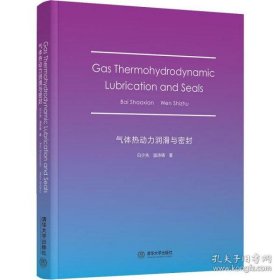
气体热动力润滑与密封 能源科学 白少先,温诗铸
正版保障 假一赔十 可开发票
¥ 71.44 8.1折 ¥ 88 全新
库存6件
作者白少先、温诗铸
出版社清华大学出版社
ISBN9787302598336
出版时间2021-12
装帧平装
开本16开
定价88元
货号29373428
上书时间2024-11-01
- 最新上架
商品详情
- 品相描述:全新
- 商品描述
-
前言
Gas lubrication is a form of fluid lubrication, which uses air or working medium gas as a lubricant to separate two friction pairs moving in relation to each other. It has the advantages of low friction resistance, high working accuracy, and a wide range of applicable temperatures, and is widely used in the design of gas-eous static pressure bearings, high-speed thrust bearings, foil bearings, mechanical seals, and other mechanical parts and equipment under extreme conditions such as extremely high or low temperatures, ultra-high or -low speeds, and ultra-precision.
In 1854, Hirm came up with the idea of using gas as a lubricant. In 1886, Reynolds deduced the Reynold’s equation describing the pressure distribution of fluid lubrication film, which raised people’s understanding of the principle of fluid lubrication to a theoretical height. In the 1950s, research on gas lubrication theory based on bearing design requirements developed rapidly. In 1959, Elrod and Burgdorfer theoretically explained that the temperature rise effect inside the lubrication gas film could be ignored under general working conditions, and the isothermal hypothesis was generally accepted in gas lubrication analysis. After the 1980s, the development of magnetic storage technology pushed the film thick-ness of gas bearings from microns to nanometers, and microscopic effects such as the gas thinning effect and surface roughness were widely studied, which pro-moted the development of gas thin film lubrication theory.
With an increase of rotation speed in mechanical equipment and the appear-ance of new bearing structures, the problem of gas thermodynamic lubrication became increasingly prominent. For example, in a gas hydrostatic bearing under the conditions of a film thickness of 20 μm, pressure of 0.7 MPa, and rotation speed of 20,000 rpm, shear heat can cause the gas film lubrication temperature to rise above 30°C. The increase of rotor temperature rise and gas viscosity can improve the stiffness and damping coefficient of the bearing, but in the absence of sufficient cooling, the bearing is prone to thermal instability, which is particu-larly prominent in a high-speed bearing design.
Compared with bearing gas lubrication dominated by shear flow, there is also pressure flow caused by seal pressure in the gas seal lubrication area. In the pro-cess of gas leakage flow from the high-pressure side to the low-pressure side, gas film temperature decreases because of rapid volume expansion, resulting in ther-mal distortion and other gas thermohydrodynamic lubrication problems.
In 1968, the John Crane Company first developed the circular arc surface spiral groove gas-lubricated seal and introduced plane spiral groove gas-lubricated seal products. With the development of gas sealing technology to high-temperature, high-pressure, high-speed, and other high parameters; the diversification of sealing media; and the continuous expansion of application fields, the surface thermal dis-tortion, supersonic flow, media phase change, and other gas thermohydrodynamic lubrication problems are increasing.
Preface
Based on the research methods and results of elastohydrodynamic lubrication theory of Prof. Wen Shizhu, this book summarizes the research results of the authors in recent years. Grounded in the application background of lubrication design of high-speed gas bearings and high-pressure gas seals, theory and analysis methods of gas thermohydrodynamic lubrication are systematically expounded. In this book, theoretical model and lubrication characteristics of gas lubrication are discussed for typical bearings and seals.
The book is divided into 10 chapters.
In Chapter 1, Properties of gases, properties of gases are introduced. Based on the principle of energy equipartition, the ideal gas state equation is decomposed into two independent gas equations.
In Chapter 2, Gas lubrication equations, the derivation of the Reynolds equa-tion, energy equation, heat conduction equation, interface equation, and other basic lubrication equations are explained. The lubrication analysis of force bal-ance and flow conservation problems are also discussed.
In Chapter 3, Isothermal gas lubrication, we introduce the modeling method and basic lubrication characteristics of isothermal gas lubrication of typical struc-tures such as the slider bearing, radial bearing, thrust bearing, and face seal.
In Chapter 4, Gas thermohydrodynamic lubrication of rigid surfaces, the gas thermodynamic lubrication law of gas-lubricated bearings and low-pressure gas seals under high-speed working conditions are analyzed without consideration of surface distortions.
Chapter 5, Gas thermoelastichydrodynamic lubrication of face seals, discusses the high-pressure gas face seal, the modeling method of TEHL, and fundamental characteristics of choked flow effect, thermoelastic distortion of seal faces, and the temperature distribution of gas film.
In Chapter 6, Transient thermoelastichydrodynamic gas lubrication of face seals, targets the gas face seal, dynamic load characteristics of the seal gas film under the conditions of isothermal lubrication, rigid surface thermal lubrication, and TEHL, exploring these in detail.
Chapter 7, Vapor-condensed gas lubrication of face seals, explores the face seal of high-pressure gas, the law of condensation and precipitation of water vapor in the seal gas film, and the movement of liquid drops in the seal gap under TEHL conditions.
Chapter 8, Cryogenic gas lubrication of face seals, uses the inclined ellipse dimpled gas face seal as an example and natural gas as the sealing medium to introduce the modeling method of cryogenic gas lubrication and the fundamental characteristics of phase change in seal film and thermoelastic distortion of seal faces.
In Chapter 9, Surface grooves of gas face seals and testing technology, typical seal grooves and their laser processing methods and experimental measurement methods are presented. Opening characteristics, hydrodynamic characteristics, and friction characteristics of gas face seals are discussed by taking the micro-dimpled face seal as an example.
Preface III
In Chapter 10, Design of gas face seals, an internal flow single-face spiral groove gas seal is used as an example to introduce the basic method and design process of gas face seals.
In the process of compiling this book, Prof. Huang Ping has given great sup-port and help. Here I would like to express my sincere gratitude. At the same time, I would like to express my heartfelt thanks to my colleagues and graduate students who have given me warm support and help in the preparation of this book.
Bai Shaoxian
Hangzhou
导语摘要本书全面系统的阐述了气体润滑与密封的理论和设计分析方法。内容包括:气体状态方程与基本性质、气体润滑方程、等温气体润滑理论、刚性表面气体热润滑理论、气体密封热弹流润滑理论、端面密封气体热弹流动态特性、高压气体冷凝析水润滑、密封实验与设计方法。
商品简介本书全面系统的阐述了气体润滑与密封的理论和设计分析方法。内容包括:气体状态方程与基本性质、气体润滑方程、等温气体润滑理论、刚性表面气体热润滑理论、气体密封热弹流润滑理论、端面密封气体热弹流动态特性、高压气体冷凝析水润滑、密封实验与设计方法。
作者简介白少先,男,1976年生,博士,浙江工业大学研究员、博士生导师。1998年7月毕业于山东轻工业学院机械设计与制造专业,获学士学位;2001年7月毕业于太原理工大学机械设计及理论专业,获硕士学位;2004年7月毕业于华南理工大学机械设计及理论专业,获博士学位;2006年11月从清华大学机械工程博士后流动站出站,进入浙江工业大学工作;2011年9月至2012年2月,在美国宾夕法尼亚大学从事访问学者研究。现为中国机械工程学会高级会员,中国机械工程学会摩擦学分会青年工作委员会委员,气体润滑专业委员会副主任委员,入选浙江省151人才计划第三层次、浙江省高校中青年学科带头人,获浙江省自然科学杰出青年基金资助。主要从事高温界面流体润滑与发动机密封研究,重点在高温流体润滑理论、密封表面减磨耐磨新结构设计、密封表面精密加工技术、密封实验测试技术、密封寿命预测与可靠性评定等方面开展工作。主持国家自然科学基金、浙江省自然科学基金、浙江省科技计划项目、清华大学摩擦学国家重点实验室开放基金项目、企业密封技术研发项目等10余项。发表SCI论文20余篇,获授权国家发明专利8项。
目录CHAPTER 1 Properties of gases.1
1.1 Gas equations 1
1.1.1 Ideal gas equations.. 2
1.1.2 Gas index equation.. 3
1.1.3 Actual gas equation. 5
1.1.4 Degree of gas molecular freedom .. 5
1.1.5 Specific heat capacity 7
1.2 Viscosity ..7
1.3 Property of wet gas .11
1.3.1 Pressure .. 12
1.3.2 Humidity. 13
1.3.3 Dew point temperature 14
References 14CHAPTER 2 Gas lubrication equations. 15
2.1 Reynolds equation 15
2.1.1 Derivation of Reynolds equation.. 16
2.1.2 Reynolds equation in the polar coordinate system . 19
2.1.3 Reynolds equation in the cylindrical coordinate system.. 19
2.1.4 Lubrication parameters .. 202.2 Energy equation.22
2.2.1 Chang of gas inner energy 23
2.2.2 External work on gas and energy loss 24
2.3 Solid heat conduction equation and the interface equation ..26
2.4 Numerical analysis method.27
2.4.1 Finite difference method 27
2.4.2 Flow conservation. 28
2.4.3 Friction force balance . 34
References 35CHAPTER 3 Isothermal gas lubrication .. 37
3.1 Sliders .37
3.1.1 Lubrication equation 38
3.1.2 Pressure boundary condition 40
3.1.3 Lubrication performance parameters.. 40
VI Contents
3.2
3.3
CHAPTER 4
4.1
4.2
4.3
4.4
3.1.4 Hydrodynamic lubrication characteristics of sliders.. 413.1.5 Hydrodynamic lubrication characteristics of divergent sliders .. 43
3.1.6 Lubrication characteristics of the magnetic head slider . 45 Journal bearing and radial seal .51
相关推荐
— 没有更多了 —













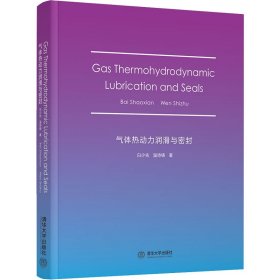
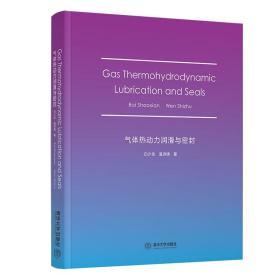
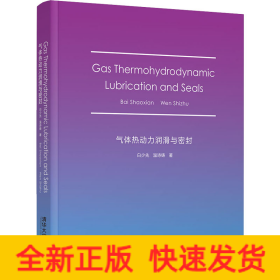
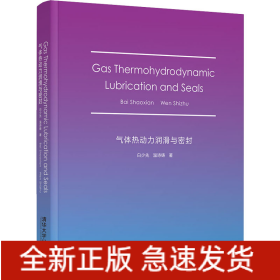





以下为对购买帮助不大的评价